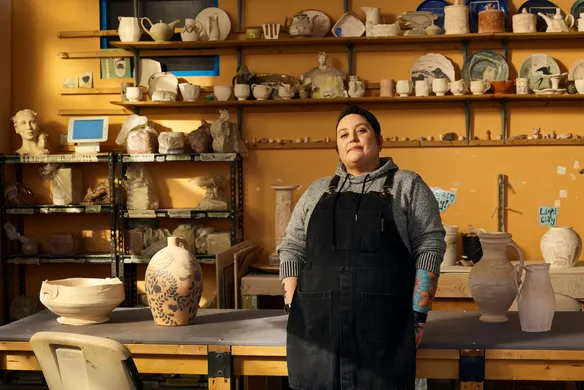Table of contents
Gone are the days when artworks can only be sold in galleries. Selling your artworks online is a great way to connect with buyers from all around the world.
Selecting the right channels and ensuring you make it easy for customers to purchase your work is critical. For best results, create points of sale on existing online platforms as well as creating your own website.
Here are our top tips for selling art online.
Create a Website to Sell Art Online
Having your own website gives you an online presence that you can completely customise and make your own.
When you create an effective online website gallery for your artworks, you will be able to showcase your style and show off your pieces to potential buyers and collectors
A website is an integral component of your marketing mix; more than 90% of business owners believe having their website contributes effectively to their digital marketing strategy.
Use a website builder
There are lots of website platforms you can use to build a website. Some systems are very simple to use but might not have many options in terms of customisation. Others are more complex but can offer a better user experience.
As you are deciding which platform to use for your website, think about how much experience you have and if you have time to learn the system and how much time you can invest in maintenance.
Systems like Square Online have been made for artists just like you. You don’t need to have a background in tech or web development or computing, to create an attractive and engaging website.
Organise artwork into categories
Whichever website builder you use, you will need to make sure that your works are sorted into logical categories online to make it easy for people to navigate through your collection.
You may focus on selling “traditional” artworks on canvas, or use your images and designs on other objects such as clothing, furnishings or giftware.
A simple, well organised and highly searchable website will strengthen and streamline your online presence.
Buyers may want to view works in a particular format, style, by price or size. Websites that are intuitive for users to browse and navigate will perform better than those which have randomly displayed collections.
Make an effort to display your works effectively – more than 90% of first impressions of a website are design related.
Set up ‘add to cart’ and payment processes
Of course, your website needs to do more than just showcase your work. You also need to provide customers with easy to use payment options that allow transactions to be processed quickly and securely. The cart function is a necessary element of any website, allowing buyers to make multiple purchases at once, easily view their total spend and any shipping or handling costs.
Embedding a “Buy Now” button on pages displaying available pieces is a simple way to convert clicks to sales through an online checkout.
These processors can be installed as plug-ins and give an effective website billing and receipt system with payment options for PayPal and credit cards, along with discount and shipping fields.
Sell artwork through other online forms
There are plenty of existing platforms and channels where you can sell your artwork. Creating a profile on platforms like Etsy and Instagram, for example, will help increase your exposure and visibility.
Create an Etsy shop
Many creative people use Etsy to sell their art. The platform can connect you with new customers, but it also takes some work to set up a shop, establish your brand and get noticed on Etsy.
To become competitive in this crowded marketplace, make sure you create a store that tells your story and helps you establish a unique brand. Make sure to get great photos of your artworks, use detailed and well-written product descriptions and are very clear about sizing options.
Make sure your Etsy shop is linked to your other social media accounts and website, so buyers can get the complete picture of who you are and what you offer.
Did you know, Etsy and Square have a partnership to enable sales in person, and improved post-sale synching.
Use an Instagram Business account to make money
Instagram is one of the most popular social media platforms in the world, and with its focus on visual content, it provides an excellent platform for selling works of art. Instagram for Business accounts give you more flexibility than individual accounts and makes it easier for you to sell artworks online. All you need to do is switch your account to a business profile to get started.
The “Shop Now” and “View Product” options through Instagram Shopping can take potential buyers directly to your online galleries from within a viewed post.
Accept commission work
The more visible that your work and profile are online, the higher the chances you will be asked to create commission work. Accepting commissions can be a great way to improve how to make money with art online.
There is high demand in the art market for customised and commissioned pieces, and often these jobs come through social media connections.
Decide what type of commissions you are interested in accepting
If you are going to accept commissions, provide potential customers with a list of their options. Be clear about what mediums you can work in, whether you can work from a sketch or photo and what size pieces you can produce.
State your trading terms clearly, including licensing and ownership details and create an agreement around pricing. It’s wise to ask for 50% upfront and state a “kill fee” which is the amount to be paid if the job falls through before completion.
Don’t be afraid to say no if you don’t feel comfortable with a commission request, or don’t think you would be able to achieve a result you would be happy with.
Create an online form to offer quick commission requests
If a buyer is interested in your style but can’t find the exact piece they are after, or, if they have fallen in love with a piece that is already sold, you will want to make it as simple, quick and easy as possible for them to contact you.
Your online commission form should capture the basic details of their request. It’s worth remembering that a form that is too detailed or requires them to create an account or password is likely to put people off.
Responding promptly to any commission contacts is also important. Follow the lead before the potential buyer changes their mind or finds someone else.
Keep up with the inventory of artwork
It may seem like your worst nightmare, but keeping your inventory up-to-date is critical when selling in an online environment. There’s nothing that annoys buyer more than attempting to purchase an artwork that appears to be for sale but is actually unavailable. Proper inventory management will help you take care of and keep secure any pieces waiting to be sold.
Create an inventory with as much detail to each listing as you can. If you are keeping up with your inventory, you will be recording the title, dimensions, work number, date and price against each piece. Recording all of these details will also be useful when you are ready to list the item online, making it easier for customers to see various works displayed and quickly find the information they are after.
Choose a method of online purchase fulfillment
Completing and selling your artworks are not the only tasks associated with making money for art online.
Once your piece is sold, you will have to have a way to provide it to the buyer! Purchase fulfillment refers to the processes associated with creating, storing and shipping your artworks to your buyers.
As your business grows, you may need to consider using extra storage or warehouse space to hold your stock.
You can also engage a third party to manage the printing storage, packing and shipping of your pieces on your behalf. Print-on-demand services are great if you are selling your art on clothing or other objects. Using this approach, you only print items when an order is placed, meaning you don’t even have a large supply of stock sitting around.
Track sales and stock to keep up with demand
A sound inventory system will prove invaluable for reporting as the sales start rolling in. If you have got multiple selling points and are using more than one channel for sales, integrating stock data will help you give customers an accurate and up-to-date display of works and services available. Remember, consistency across your channels is important.
An online inventory management tool will also help you update individual listings, or manage inventory in bulk.
Staying on top of your inventory will enable you to receive and run orders efficiently and won’t see you out of pocket and overcommitted with stock or supplies.
Enjoy the process of selling your art
So, in a nutshell, It all comes down to selecting the right tools and platforms, having a strong online presence and making it easy for customers to commission and purchase artwork.
The best part of it all is to enjoy the process. Marketing your work online can be incredibly rewarding, especially when you make true and genuine connections with your customers.
![]()











